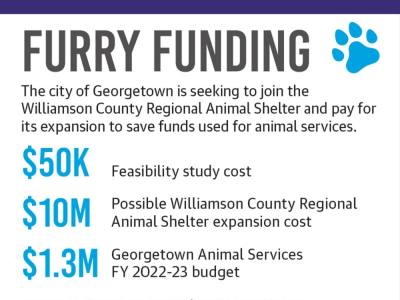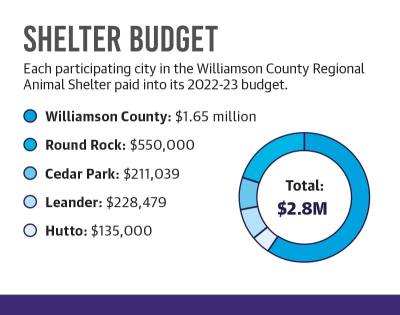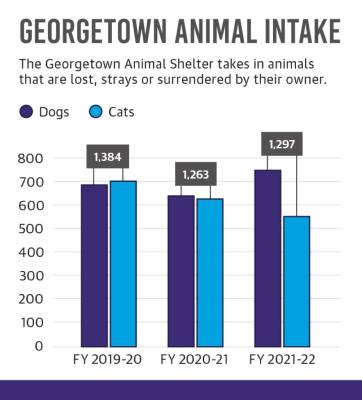In addition to the county, the WCRAS serves the cities of Leander, Round Rock, Cedar Park and Hutto. The organization could begin serving Georgetown as the Williamson County Commissioners Court approved a feasibility study March 21 to determine whether it is practical.
Georgetown’s involvement could lower the city’s expenses for taking care of stray animals, but it also will require more staff as well as an expansion to the existing WCRAS facility. Georgetown would need to pass a bond election later this year to fund these efforts.
"If we don’t expand some how, some way, it will definitely put stressors on the work that we do,” Georgetown Animal Services Manager April Haughey said.
Uniting forces
The WCRAS is a combined effort to assist the area’s pet population. Each participating entity pays for its portion of animal intake with Williamson County responsible for the majority—59.12%—of the $2.8 million budget in fiscal year 2022-23. Each city and the county would have to approve an agreement to bring in Georgetown.
“If we’re struggling to keep our head above water now, ... how are we going to manage the expanded capacity?” County Judge Bill Gravell said prior to voting against the feasibility study.
Georgetown has proposed spending around $10 million on an expansion to the WCRAS. Funding for this expansion would come from a potential November bond. The city would also pay for its portion of the cost to run the facility.
Jackson Daly, Georgetown’s assistant director of public works, said city officials hope to structure the budget so it wouldn’t impact other cities’ costs.
Georgetown spends roughly $800,000 of its $1.3 million animal services budget to maintain its facility and is in need of a larger city-run shelter if it doesn’t join the WCRAS.
“It’s going to be less expensive for us to expand the regional animal shelter versus building a brand-new one for us,” Daly said.
Capacity concerns
The WCRAS dog population was at 165% capacity as of mid-April. The Georgetown shelter housed as many as 45 dogs in 29 kennels in recent months.
In 2019, the WCRAS completed a $10.5 million renovation and expansion, adding a new adoption center in a separate two-story building with 64 additional canine kennels and 93 feline kennels.
The shelter is considered at critical capacity when it has 170 dogs or more. As of early April, the shelter was caring for 182 dogs.
“I don’t know that we’ve ever gotten into trouble with cats in the same way we are with dogs right now,” WCRAS Program Coordinator April Peiffer said. “With dogs, we’ve been at critical capacity or beyond since May of last year.”
When one shelter fills up, it can also have a “snowball effect,” Haughey said.
“Hypothetically, let’s just say Austin [shelters are] filling up,” she said. “Well, when they have more people wanting to surrender to a shelter, then they start branching out and trying other areas.”
In FY 2021-22, 3,274 dogs were brought to the WCRAS. Of those, 721 were owner surrenders. At the city shelter, 134 of the 746 dogs it received were owner surrenders.
“It would be great if we had responsible pet owners in our county that did not come to the county and try to return animals,” said Precinct 3 Commissioner Valerie Covey, who also chairs the WCRAS board. “We have plenty of animals, thank you very much. We would love for you to adopt more of them.”
Funding and fixes
Officials said it’s difficult to point to one cause of overcrowding, but rather it’s due to a combination of factors, including an increased population, rising inflation costs and less access to veterinary care.
To handle the increased load, shelters are taking extra efforts to promote pet adoption, utilize volunteers and make the most out of their space.
The regional shelter staff and volunteers have ramped up efforts in recent months, spearheading more adoption events and boosting community outreach efforts. The county also transports dogs to other states where shelters have room.
Peiffer said shelter spikes are surpassing available capacity even as the WCRAS budget continues to increase, rising to $2.8 million in FY 2022-23 from $2.6 million the year prior.
In Georgetown, the city has increased its animal service budget from around $913,000 in FY 2020-21 to almost $1.3 million in FY 2022-23.
The city shelter also utilizes volunteers. While staff handles the core functions of the facility, such as interacting with customers, answering phone calls and providing medical care, volunteers walk animals and do other essential tasks, such as laundry, Haughey said.
“We couldn’t do half of what we do without our volunteer base,” she said.
Daly said he hopes linking up with the WCRAS to expand its facility and budget will help both entities.
The city has until Aug. 21 to call an election for the November ballot. If the bond fails, Daly said the city would be back to the drawing board to find a way to expand its building or construct a new one.
“There’s a lot of things that have to fall into place,” Daly said.











